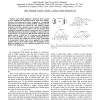Free Online Productivity Tools
i2Speak
i2Symbol
i2OCR
iTex2Img
iWeb2Print
iWeb2Shot
i2Type
iPdf2Split
iPdf2Merge
i2Bopomofo
i2Arabic
i2Style
i2Image
i2PDF
iLatex2Rtf
Sci2ools
DAC
2004
ACM
2004
ACM
Reducing clock skew variability via cross links
Increasingly significant variational effects present a great challenge for delivering desired clock skew reliably. Non-tree clock network has been recognized as a promising approach to overcome the variation problem. Existing non-tree clock routing methods are restricted to a few simple or regular structures, and often consume excessive amount of wirelength. In this paper, we suggest to construct a low cost non-tree clock network by inserting cross links in a given clock tree. The effects of the link insertion on clock skew variability are analyzed. Based on the analysis, we propose two link insertion schemes that can quickly convert a clock tree to a non-tree with significantly lower skew variability and very limited wirelength increase. In these schemes, the complicated non-tree delay computation is circumvented. Further, they can be applied to the recently popular non-zero skew routing easily. The effectiveness of the proposed techniques has been validated through SPICE based Monte ...
Clock Routing Methods | Clock Skew Variability | DAC 2004 | Design Automation | Lower Skew Variability |
| Added | 13 Nov 2009 |
| Updated | 13 Nov 2009 |
| Type | Conference |
| Year | 2004 |
| Where | DAC |
| Authors | Anand Rajaram, Jiang Hu, Rabi N. Mahapatra |
Comments (0)

